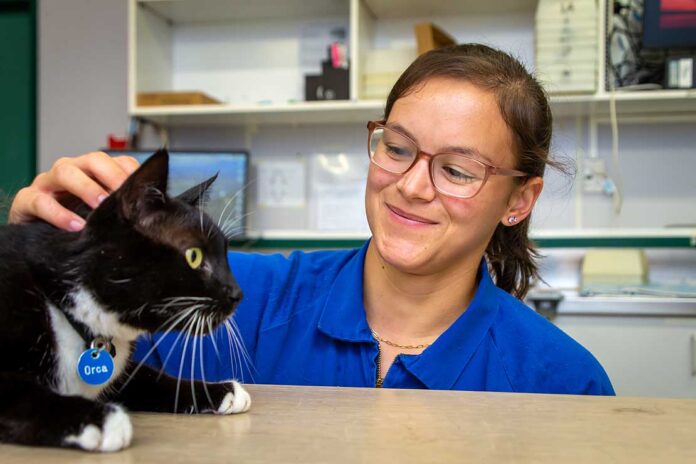Source: Massey University
Pavinee Watson loves receiving support from different experts for her PhD project.
Animal Science PhD candidate Pavinee Watson gives us an insight into her Massey journey.
Tell us a bit about yourself and why you chose to study at Massey.
I am Pavinee Watson, a third year Animal Science PhD candidate. I originally enrolled in the pre-vet programme at Massey, with little intention of getting into veterinary science. This simply allowed me to try out the vet selection and have time to consider what I may want to do without taking a gap year.
Tell us about your journey at Massey so far.
After completing the initial pre-vet semester, I went on to study a Bachelor of Food Technology majoring in Food Product Technology. As part of this degree, you do an Honours project in your final year. Mine involved developing a pet food supplement which was very interesting. I travelled around the country to do summer practicums and ended up continuing with pet food research by completing a Master of Food Technology, which was funded through the Dick and Mary Earle Scholarship in Technology along with industry support from a New Zealand pet food company.
The question investigated in my Master’s project has been dissected further in my PhD, which is a project funded by Callaghan Innovation, AgResearch and a New Zealand-based pet food company. It’s great to see the importance of pet food research not only in academia but in the industry itself.
How would you describe your PhD and why you chose this area?
In my PhD project, I am looking to determine what is driving the preference for various meat ingredients in commercial cat food. This includes pulling apart a commercial diet and examining on a fundamental level, what may be responsible for cat food preference.
I chose this area of study because the New Zealand pet food industry utilises a large amount of meat by-products. As an agricultural nation, we produce a lot of lean meat for humans but compared to other countries, the consumption of organ meats is not considered the norm in New Zealand. Meat by-products can in fact make up a large portion of a carcass that would otherwise go to waste, but such ingredients are considered a great source of protein with high nutrient bioavailability, so its use in pet food not only provides quality nutrition but is also great in terms of palatability.
What do you love about studying at Massey?
I love receiving support from different experts for my PhD project. Although they specialise in different areas such as animal science, meat science, food technology, added value foods and bio-based products, it is exciting to see all the fields coming together and enabling my research to flourish.
Where do you see yourself after studying?
Just like at the start of my Massey journey, I am not sure what I will do after I finish studying. There are many options available such as doing a post-doctorate, working for a research company or going into the pet food industry and creating new products. At the moment, I will keep chipping away at my PhD.
Do you have any advice for other PhD students?
PhD students can easily get tunnel vision and just want to keep going but it is important to take breaks, go for a walk, and look at those results after getting some fresh air. If you finish a trial that has been running for eight weeks, take a couple of days off. I remember after my first trial, I was so burnt out and felt immense guilt for taking a week to recover. Then I realised that I was working flat out for so long and needed to remember to look after myself. There is life outside of your project, just make sure you plan your project time wisely and always have time in there to do what you enjoy. That will help you focus in the office, lab, or out in the field.




